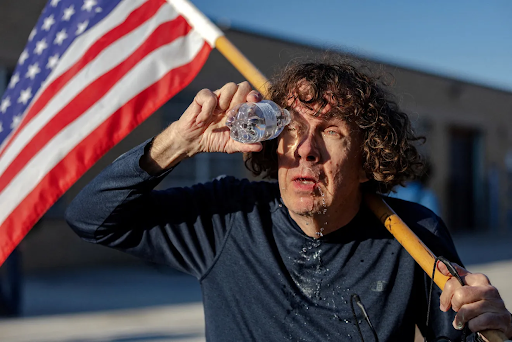“Operation Midway Blitz”: ICE’s Latest Raids In Chicago
A protester rises their eyes after teargas and pepper balls were deployed outside of the Broadview ICE facility on September 26th. Source: USA Today.
On September 8th, the Trump administration began its latest citywide crackdown on undocumented immigration in one of the US’s largest and most diverse sanctuary cities: Chicago. This designation as a “sanctuary city” means that Chicago will not turn away immigrants due to their legal status, will not share residents’ immigration status with officials in the Federal government, nor will the city deny access to essential services for any undocumented person. This places Chicago at odds with the Federal government and its promise to deport a historic number of undocumented immigrants. The Trump administration, for these reasons, has begun arresting and investigating Chicago’s immigrant population, using ICE (Immigration Control and Enforcement) to carry out raids on apartment complexes, work sites, and other places throughout the city—echoing the speed, if not the ferocity, of similar operations in Los Angeles and Washington D.C. This operation, termed “Operation Midway Blitz” by ICE and DHS (Department of Homeland and Security), has led to the arrest of 400 people in around two weeks, a number which is steadily rising.
This number of arrests speaks to the operation’s scope, with Customs and Border Protection spokesman David Kim noting that DHS and ICE intend to use all resources at their disposal to investigate and apprehend what they describe as “illegal immigrants”. This includes land, sea, and air capabilities. The Trump administration has also stated that it will be committing National Guard troops to Chicago if necessary. This rhetoric and implementation of resources mark an unprecedented shift in the executive’s approach to immigration enforcement.
This new approach has been met with major criticism from advocacy groups, elected officials, and everyday citizens concerned by the increasing militarization of their city’s streets. ICE entered Chicago on September 8th, with a mandate from President Trump to essentially clean-up the city, which meant arresting undocumented immigrants and questioning those whom ICE and DHS suspected of being undocumented. ICE did this without the consent or prior knowledge of either Illinois’ governor, J.B. Pritzker, or Chicago’s mayor, Brandon Johnson, both of whom spoke out against these actions on social media. Federal agents, in addition to arresting undocumented immigrants, detained some Chicagoans who held legal status in the US, leading to a citywide fear that anyone could be apprehended next; “50% to 60% of the arrests were targeted,” which means specific undocumented immigrants whom ICE had already been investigating due to criminal activity, orders for deportations, or for other reasons. The other forty percent, however, have been the “collateral arrests” of unlucky undocumented immigrants caught-up in the wider net ICE’s operations.
The ICE raids in Chicago have come at a time when the Trump administration’s rhetoric against sanctuary cities is intensifying , with DHS claiming that “Operation Midway Blitz” would “target the criminal undocumented aliens who flocked to Chicago”, echoing Trump’s characterization of the city as a haven for illegal immigration. The administration has expressed particular criticism over state and local policies that have intentionally hindered law enforcement cooperation with ICE, seeing these policies as quasi-illegal roadblocks standing in the way of their mandate to tackle illegal immigration.
While many of Trump’s supporters see ICE and DHS operations in Chicago, and across the US, as necessary checks against undocumented immigration, the backlash to “Operation Midway Blitz” has been widespread. Protestors who oppose ICE’s actions have rallied at detention centers to intervene as ICE vehicles entered gated facilities on the city’s outskirts. Most of these demonstrations have centered around the Broadview ICE facility, the main building housing detained undocumented immigrants, as well as those arrested for impeding ICE’s operations. Located in one of Chicago’s suburbs, Broadview has come under scrutiny from activists for its alleged inhumane conditions, with one detainee, a man named Rogelio Huerta, noting that ICE agents “refused [him] a phone call, they refused food, they refused any kind of essentials that [he] needed.” This and similar protests have raised concerns about the nature of ICE’s response in Chicago, as well as the methods they have used to detain those arrested under this most recent operation.
Demonstrators have also consistently clashed with ICE and DHS outside many of these facilities, with some turning violent. Most recently, agents deployed the use of chemical gas as well as pepper bombs against a group of protestors blocking ICE vehicles from entering the Broadview facility. In addition to this, protestors have been arrested while demonstrating in front of Broadview, with over a dozen people detained outside the facility. These clashes have been spurred by residents’ fears over ICE’s unchecked power to operate in the city, as well as by accounts of U.S. citizens who federal officers wrongly detained. In addition to this, the death of a man shot by an ICE officer on September 12 has galvanized public dissent.
Although the operations in Chicago have just begun, they have already been characterized by large-scale, coordinated raids across neighborhoods, mass detentions, and intense public backlash. Many Chicago residents have expressed general feelings of fear and unease as the operations promise to intensify, while others praise the administration for punishing those who break the law. The larger debate over immigration in the United States shows no signs of calming down, and, as the precedent set in Los Angeles, D.C., and now Chicago indicates, this administration shows no signs of slowing its controversial campaign against undocumented immigration.

